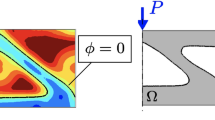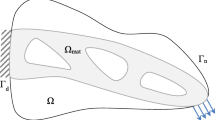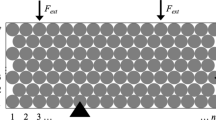Abstract
A new approach for generating stress-constrained topological designs in continua is presented. The main novelty is in the use of elasto-plastic modeling and in optimizing the design such that it will exhibit a linear-elastic response. This is achieved by imposing a single global constraint on the total sum of equivalent plastic strains, providing accurate control over all local stress violations. The single constraint essentially replaces a large number of local stress constraints or an approximate aggregation of them – two common approaches in the literature. A classical rate-independent plasticity model is utilized, for which analytical adjoint sensitivity analysis is derived and verified. Several examples demonstrate the capability of the computational procedure to generate designs that challenge results from the literature, in terms of the obtained stiffness-strength-weight trade-offs. A full elasto-plastic analysis of the optimized designs shows that prior to the initial yielding, these designs can sustain significantly higher loads than minimum compliance topological layouts, with only a minor compromise on stiffness.












Similar content being viewed by others
References
Allaire G, Jouve F (2008) Minimum stress optimal design with the level set method. Eng Anal Bound Elem 32(11):909–918
Amir O (2011) Efficient reanalysis procedures in structural topology optimization. PhD thesis, Technical University of Denmark
Amir O (2013) A topology optimization procedure for reinforced concrete structures. Comput Struct 114–115:46–58. doi:10.1016/j.compstruc.2012.10.011. http://www.sciencedirect.com/science/article/pii/S0045794912002337
Amir O, Sigmund O (2013) Reinforcement layout design for concrete structures based on continuum damage and truss topology optimization. Struct Multidiscip Optim 47(2):157–174. doi:10.1007/s00158-012-0817-1
Amstutz S, Novotny A A (2010) Topological optimization of structures subject to von mises stress constraints. Struct Multidiscip Optim 41(3):407–420
Bendsøe MP (1989) Optimal shape design as a material distribution problem. Struct Optim 1(4):193–202
Bendsøe MP, Kikuchi N (1988) Generating optimal topologies in structural design using a homogenization method. Comput Methods Appl Mech Eng 71(2):197–224
Bendsøe MP, Sigmund O (2003) Topology optimization - theory, methods and applications. Springer, Berlin
Bogomolny M, Amir O (2012) Conceptual design of reinforced concrete structures using topology optimization with elastoplastic material modeling. Int J Numer Methods Eng 90(13):1578–1597. doi:10.1002/nme.4253
Bourdin B (2001) Filters in topology optimization. Int J Numer Methods Eng 50:2143–2158
Bruggi M (2008) On an alternative approach to stress constraints relaxation in topology optimization. Struct Multidiscip Optim 36(2):125–141
Bruggi M, Duysinx P (2012) Topology optimization for minimum weight with compliance and stress constraints. Struct Multidiscip Optim 46(3):369–384
Bruggi M, Venini P (2008) A mixed fem approach to stress-constrained topology optimization. Int J Numer Methods Eng 73(12):1693–1714
Bruns T E, Tortorelli D A (2001) Topology optimization of non-linear elastic structures and compliant mechanisms. Comput Methods Appl Mech Eng 190:3443–3459
Cheng G, Guo X (1997) ε-relaxed approach in structural topology optimization. Struct Optim 13(4):258–266
Cheng G, Jiang Z (1992) Study on topology optimization with stress constraints. Eng Optim 20(2):129–148
Deaton J, Grandhi R (2014) A survey of structural and multidisciplinary continuum topology optimization: post 2000. Struct Multidiscip Optim 49(1):1–38. doi:10.1007/s00158-013-0956-z
Duysinx P, Bendsøe MP (1998) Topology optimization of continuum structures with local stress constraints. Int J Numer Methods Eng 43:1453–1478
Duysinx P, Sigmund O (1998) New developments in handling stress constraints in optimal material distribution. In: Proceedings of 7th AIAA/USAF/NASA/ISSMO symposium on multidisciplinary design optimization, AIAA, Saint Louis, Missouri, AIAA Paper, pp 98–4906
Eschenauer H A, Olhoff N (2001) Topology optimization of continuum structures: a review. Appl Mech Rev 54(4):331–389
Fancello E (2006) Topology optimization for minimum mass design considering local failure constraints and contact boundary conditions. Struct Multidiscip Optim 32(3):229–240
Fritzen F, Xia L, Leuschner M, Breitkopf P (2015) Topology optimization of multiscale elastoviscoplastic structures. Int J Numer Methods Eng
Guest J K, Prévost J H, Belytschko T (2004) Achieving minimum length scale in topology optimization using nodal design variables and projection functions. Int J Numer Methods Eng 61:238– 254
James K A, Waisman H (2014) Failure mitigation in optimal topology design using a coupled nonlinear continuum damage model. Comput Methods Appl Mech Eng 268:614–631
James K A, Waisman H (2015) Topology optimization of viscoelastic structures using a time-dependent adjoint method. Comput Methods Appl Mech Eng 285:166–187
Kato J, Hoshiba H, Takase S, Terada K, Kyoya T (2015) Analytical sensitivity in topology optimization for elastoplastic composites. Struct Multidiscip Optim 1–20
Kirsch U (1990) On singular topologies in optimum structural design. Struct Optim 2(3):133–142
Le C, Norato J, Bruns T, Ha C, Tortorelli D (2010) Stress-based topology optimization for continua. Struct Multidiscip Optim 41:605–620
Maute K, Schwarz S, Ramm E (1998) Adaptive topology optimization of elastoplastic structures. Struct Optim 15(2):81–91
Michaleris P, Tortorelli D A, Vidal C A (1994) Tangent operators and design sensitivity formulations for transient non-linear coupled problems with applications to elastoplasticity. Int J Numer Methods Eng 37(14):2471–2499
Nakshatrala P, Tortorelli D (2015) Topology optimization for effective energy propagation in rate-independent elastoplastic material systems. Comput Methods Appl Mech Eng 295:305–326. doi:10.1016/j.cma.2015.05.004. http://www.sciencedirect.com/science/article/pii/S004578251500170X
París J, Navarrina F, Colominas I, Casteleiro M (2007) Block aggregation of stress constraints in topology optimization of structures. In: Hernández S, Brebbia CA (eds) Computer aided optimum design of structures, vol 10
París J, Navarrina F, Colominas I, Casteleiro M (2010) Block aggregation of stress constraints in topology optimization of structures. Adv Eng Softw 41(3):433–441
Park YK (1995) Extensions of optimal layout design using the homogenization method. PhD thesis, University of Michigan, Ann Arbor
Pereira JT, Fancello EA, Barcellos CS (2004) Topology optimization of continuum structures with material failure constraints. Struct Multidiscip Optim 26(1–2):50–66
Rozvany G (1996) Difficulties in truss topology optimization with stress, local buckling and system stability constraints. Struct Optim 11(3-4):213–217
Schwarz S, Maute K, Ramm E (2001) Topology and shape optimization for elastoplastic structural response. Comput Methods Appl Mech Eng 190(15):2135–2155
Sigmund O, Maute K (2013) Topology optimization approaches. Struct Multidiscip Optim 48(6):1031–1055
Sigmund O, Torquato S (1997) Design of materials with extreme thermal expansion using a three-phase topology optimization method. J Mech Phys Solids 45(6):1037–1067
Simo J, Taylor R (1986) A return mapping algorithm for plane stress elastoplasticity. Int J Numer Methods Eng 22:649–670
Simo JC, Hughes TJ (2006) Computational inelasticity, vol 7. Springer Science & Business Media
Stolpe M, Svanberg K (2001) On the trajectories of the epsilon-relaxation approach for stress-constrained truss topology optimization. Struct Multidiscip Optim 21(2):140–151
Svanberg K (1987) The method of moving asymptotes - a new method for structural optimization. Int J Numer Methods Eng 24:359–373
Sved G, Ginos Z (1968) Structural optimization under multiple loading. Int J Mech Sci 10(10):803–805
Swan CC, Kosaka I (1997) Voigt-reuss topology optimization for structures with nonlinear material behaviors. Int J Numer Methods Eng 40(20):3785–3814
Verbart A, Langelaar M, van Keulen F (2016) Damage approach: a new method for topology optimization with local stress constraints. Struct Multidiscip Optim 53(5):1081–1098
von Mises R (1928) Mechanics of the ductile form changes of crystals. Z Angew Math Mech 8:161–185
Xu S, Cai Y, Cheng G (2010) Volume preserving nonlinear density filter based on heaviside functions. Struct Multidiscip Optim 41(4):495–505. doi:10.1007/s00158-009-0452-7
Yang R, Chen C (1996) Stress-based topology optimization. Struct Optim 12(2-3):98–105
Yoon GH, Kim YY (2007) Topology optimization of material-nonlinear continuum structures by the element connectivity parameterization. Int J Numer Methods Eng 69(10):2196–2218
Yuge K, Kikuchi N (1995) Optimization of a frame structure subjected to a plastic deformation. Struct Optim 10(3-4):197–208
Zienkiewicz OC, Taylor RL (2000) The finite element method: solid mechanics, vol 2. Butterworth-Heinemann
Acknowledgments
This research was supported by the Israel Science Foundation (grant No. 750/15).
Author information
Authors and Affiliations
Corresponding author
Appendix
Appendix
In this appendix we present a numerical verification of the adjoint sensitivity analysis procedure. Implementing this procedure can be a somewhat cumbersome task, so we believe this verification can prove useful for readers who are not well-acquainted with such procedures. Furthermore, accurate and efficient sensitivity analysis for elasto-plastic response is still a rather open issue, as discussed in a recent publication (Kato et al. 2015). In the following, results of the adjoint computations are compared to numerical derivatives computed by forward finite differences.
We consider a small problem of a symmetric clamped beam, where the symmetric half is modeled with a finite element mesh of 2 ×2 square bi-linear elements. A downwards vertical displacement is prescribed at the top right corner. Two separate loading situations are considered, see Fig. 13 for the problem setup: 1) A point load at the top right corner; and 2) A distributed load at the right edge. The first case is easier to implement because the equations for the global adjoint vectors in (23) and (25) take a simple form when the force is applied only at the prescribed DOF. However, the second case is much more useful, especially in the particular application considered in this article: It is necessary to distribute the applied load over several adjacent nodes because the numerical solution with a point load will inherently include stress concentrations.
The material and optimization parameters are given in Table 5. The density \(\overline {x}_{e}\) in all four elements is set to 0.8. The prescribed displacement of 0.01 is applied within 10 equal increments. Convergence of each increment is assumed when the relative norm of the residual forces is below 10−6. For the finite difference check, the perturbation value is set to \({\Delta } \overline {x}_{e} = 10^{-6}\). We compare the design sensitivities of two critical quantities in the context of the current application: 1) The end-compliance at the prescribed DOF, \(g_{ec} = -\theta _{N} \hat {{f}^{p}} {{u}_{N}^{p}}\), where the superscript p denotes the prescribed DOF; and 2) The sum of plastic strains in the whole domain at the final equilibrium state, \(g_{ps} = {\sum }_{e=1}^{N_{e}} {\sum }_{k=1}^{N_{GP}} {\kappa ^{ek}_{N}}\).
The comparisons between the derivatives computed by the adjoint procedure to those obtained by finite differences are presented in Tables 6 and 7 for the point load and distributed load, respectively. It can be seen that the design sensitivities are practically identical, thus verifying the derivation and the implementation of the adjoint procedure. The nonlinear response of both test cases is presented in Fig. 14, in terms of load-displacement curves at the prescribed DOF and equivalent plastic strain. From the tables it can be seen that even elements that are in the elastic regime contribute to the sum of plastic strains, in two opposite modes – i.e. the addition of material can either increase or decrease the overall plastic strain, whereas it always has a stiffening effect on compliance. Finally, the analysis and sensitivity analysis were repeated with 30 and 50 displacement increments. Practically identical results were obtained for the nonlinear respones as well as their design sensitivities.
Rights and permissions
About this article
Cite this article
Amir, O. Stress-constrained continuum topology optimization: a new approach based on elasto-plasticity. Struct Multidisc Optim 55, 1797–1818 (2017). https://doi.org/10.1007/s00158-016-1618-8
Received:
Revised:
Accepted:
Published:
Issue Date:
DOI: https://doi.org/10.1007/s00158-016-1618-8






